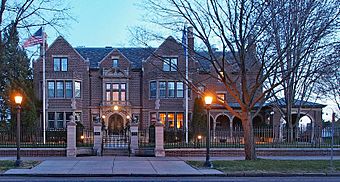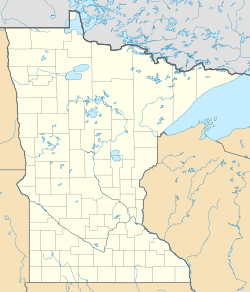Minnesota Governor's Residence facts for kids
Quick facts for kids |
|
|
Horace Hills Irvine House
|
|
|
U.S. Historic district
Contributing property |
|

The Governor's Residence in 2015.
|
|
| Location | 1006 Summit Avenue, Saint Paul, Minnesota |
|---|---|
| Built | 1910 |
| Architect | William Channing Whitney |
| Part of | Historic Hill District (ID76001067) |
| NRHP reference No. | 74001034 |
| Added to NRHP | December 16, 1974 |
The Minnesota Governor's Residence is the official home for the governor of Minnesota. People sometimes call it the Governor's Mansion. This important house is located at 1006 Summit Avenue in Saint Paul. It sits on a large piece of land, about 1.5 acres, and the building itself is over 16,000 square feet.
Contents
About the Governor's Home
This beautiful house was designed by an architect named William Channing Whitney from Minneapolis. It was built for Horace Hills Irvine, a lumber businessman from Saint Paul, and his family. The house is built in the English Tudor style. It has 20 rooms, including nine bedrooms, eight bathrooms, and nine fireplaces!
The Irvine family lived in the home for many years, from 1912 until 1965. In 1965, the youngest Irvine daughters, Clotilde Irvine Moles and Olivia Irvine Dodge, gave the house as a gift. They donated it to the people of Minnesota so it could become the official home for the state's First Family.
How the House Became Official
In 1965, the Minnesota Legislature (which is like the state's law-making group) passed a law. This law accepted the house as a gift. It also made the house the State Ceremonial Building. This meant it could be used for important state events and as the governor's home.
The law put the house under the care of the Minnesota Department of Administration. From 1965 to 1980, governors could suggest changes to the house. The Legislature provided money for these updates. A special committee also helped furnish the house from 1965 to 1967.
A Historic Landmark
In 1974, the Governor's Residence was added to the National Register of Historic Places. This is a list of important historical buildings in the United States. Being on this list means that any major changes to the outside of the house must be approved. This approval comes from the State Historic Preservation Office of the Minnesota Historical Society. The house is also part of the Historic Hill District, which is another important historical area.
Every year during the holiday season, a special tradition takes place. A forester from the Minnesota Department of Natural Resources chooses a huge Christmas tree. This tree comes from a Minnesota State Forest, often near Pine City. It is then placed on the front lawn of the Governor's Residence.
Managing the Governor's Residence
To help manage the house better, the Legislature created a group in 1980. It was first called the State Ceremonial Building Council. In 1983, its name was changed to the Governor's Residence Council.
Who is on the Council?
The council has 19 members. These include:
- The Commissioner of Administration
- The governor's spouse
- The head of the Arts Board
- The director of the Minnesota Historical Society
- One member from the Minnesota House of Representatives
- One member from the Minnesota Senate
- 13 members chosen by the governor
This council helps plan how to restore the house. They also approve any changes and ask for donations. These donations help pay for improvements or new furnishings for the public areas of the building.
Staff at the Residence
The Governor's Residence has five staff members who help keep things running smoothly. They are:
- A manager
- An assistant manager
- A chef
- A housekeeper
- A groundskeeper
During the summer, the Minnesota Historical Society sometimes offers free tours. This allows the public to visit and see parts of the historic home.
Recent Updates to the House
Starting in 2023, the Summit Avenue mansion began some important upgrades. These improvements were made to make the house more secure. They also updated the electrical, plumbing, and foundation systems. This project cost about $13 million and was paid for by taxpayers.



